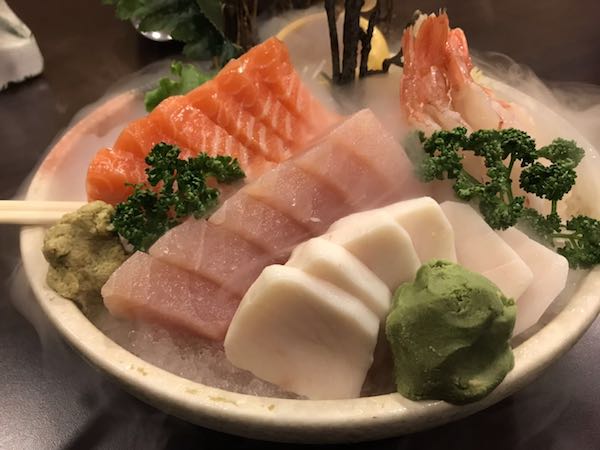We are reader supported. When you purchase through links on our site, we may earn an affiliate commission. Also, as an Amazon affiliate, we earn from qualifying purchases.

I went with my friend to the fish market yesterday. He knows that I am running a sushi blog so he asked me is it okay to make sushi with supermarket fish.
I did some research and the answer is Yes it’s possible to make sushi with supermarket fish. First, check if the fish at your supermarket is for sushi use by looking at the label. Most sushi grade fish will have a sticker that says “for raw consumption” which indicates that it is indeed safe. If there is no label, don’t risk buying it.
Fish Commonly Used for Sushi
If you are thinking of buying your own fish for sushi, you must know what kind of fish to get. Here is a list of the top choices for you.
1. Tuna
Back in the day, high-end restaurants would definitely use Bluefin Tuna in their dishes. This premium fish is rich in good fats and is quite flavorful. The Japanese have been fishing this species of fish since the 19th century which has lead to overfishing, in turn causing this breed to fall on the endangered species list. Some restaurants may still serve this kind of tuna but at an extremely high price.
Today other kinds of tuna are used such as the Yellowfin Tuna and the Big-Eye Tuna which has a more subtle flavor compared to the Bluefin Tuna but is as equally satisfying to eat.
Today other kinds of tuna are used such as the Yellowfin Tuna and the Big-Eye Tuna which has a more subtle flavor compared to the Bluefin Tuna but is as equally satisfying to eat.
2. Salmon

There has been controversy regarding the use of Salmon in sushi, due to the fact that it isn’t as popular in Japan compared to Western countries. But Salmon is still the most favored by sushi-lovers everywhere. It is quite impossible to find a Sushi Restaurant that doesn’t serve this fish that is rich in both Omega-3 Fatty Acids: Docosahexaenoic Acid (DHA) and Eicosapentaenoic Acid (EPA). It’s rich flavor and health benefits definitely appeal to the first-timers and regular consumers alike.
3. Mackerel
The Mackerel is quite popular in Japan for its strong flavor and aroma. Sushi chefs would often cure the fish in vinegar and salt to balance out the taste and top it on sushi rice on its own. It has been observed that most Westerns are not a fan of this fish due to its fishy aroma and intense flavor, making it quite uncommon to order at restaurants.
4. Halibut
This fish is quite light and delicate. It pairs well with citrus flavors which is why it is commonly used in Ceviche. It is also used for sushi and sashimi and is seasoned with grated radish, scallions and citrus soy sauce.
5. Albacore
This fish is technically under the Tuna family but is more indigent to warmer seas. The texture of the fish is quite flakey but soft and buttery at the same time. The flavor is quite light compared to regular tuna and has been quite popular recently due to its versatile nature.
Now that you have an idea of what fish to buy, you can head to the nearest supermarket and inquire of the availability of these fishes to make your own Sushi at home.
What Does “Sushi-Grade” Actually Mean?
Before actually stocking up on a variety of fishes for your homemade sushi, you must take a good look at the viability of these fishes in terms of quality and safety. The freshest fish is always the best to choose from, most fishermen would even blast freeze their catch just to be able to ensure that possible parasites within the fish will be killed.

When we talk about sushi or sashimi grade fish, we are talking about the premium quality fish or seafood in the market. This is the very reason why sushi is quite expensive in most restaurants. The label “sushi grade” is not actually regulated by the Food and Drug Association (FDA), that the association does not have a specific definition for the said term. However, the FDA has published handling guidelines on the subject matter; part of these guidelines are freezing the fish at -20o C or -68o F for 24 hours before being sold or consumed.
This process effectively kills the parasites. Some local health departments would issue laws that would require restaurants to freeze their seafood prior to serving to their customers. This extra step definitely ensures clean fish every time you order.
At home, we won’t be able to freeze fish to this temperature because home freezers, on average, can go as low as -18o C or 64.4oF. Which is why it is important to know if the fish has been frozen for 24 hrs before buying it. Some fish, like Salmon, is usually farmed. Unless there is an outbreak of parasites or bacteria within the farm itself, it is relatively safe to consume this fish even without freezing.
The FDA recommends the following as well; after choosing the fish, you must be sure to pack it in ice and immediately refrigerate it upon arriving home. If you intend to consume it raw, eat it within the day, otherwise freeze it. This should make it last for the next two days, any longer wouldn’t be recommended for raw consumption. Never let the fish reach room temperature, the probability of spoilage and bacterial build-up would definitely be higher.
To be safe, it is always better to follow the guidelines set by the FDA. Parasitic and bacterial infections can be fatal especially if not caught in time. With your health at the top priority, it is always best to be cautious especially with sushi.
Related Article: How To Choose Salmon For Sushi?
Risks in Consuming Raw Fish?
When you think of it before fire was invented, food, including meat and fish was eaten raw. But because our world has changed over the centuries, different microorganisms have developed due to a variety of man-made causes, the fish we consume is not as safe as we presume it to be. Hence, the reason why we have to take a few extra steps in ensuring that the fish we do consume raw is safe to eat.
Eating raw seafood can cause food poisoning. Take, for instance, red tide, during this time when algae blooms are the highest in number billions of pathogenic microorganisms will infect the fish we eat causing a variety of illnesses for humans when consumed.
People who are more prone to infections are pregnant women, children, older adults and those at an immuno-compromised state. Which is exactly why people within these categories are not encouraged to eat sushi, let alone make them at home.
Even healthy individuals are at risk if the sushi is not properly prepared. When making sushi at home (click to see
Related Article: Is Sushi Raw Fish?
Pathogenic Microorganisms Found in Fish?
Having talked about the risks of eating raw fish, here are a few of the microorganisms that infect fish commonly used in sushi, as well as the possible course of treatment your doctor may prescribe in the event you have been infected.
1. Anisakiasis
Commonly known as the Herring Worm, this roundworm is often seen in raw fish. According to the Center
2. Vibrio
There are two Vibrio species commonly found in raw fish that can cause severe infections. These bacterial colonies can cause bloody diarrhea, fever, nausea, and abdominal cramps. Once the pathogen has been identified, IV antibiotics will be administered to flush the bacteria out of your system. People with impaired immunity will be much harder to treat.
3. Salmonella
Contrary to popular belief, this bacteria is also found in fish and not just on chicken and chicken products. Signs and symptoms of the infection may not manifest up until the third day from food consumption which is why when you do feel any of their common symptoms, visiting the Emergency Room would be a matter of life and death. Salmonella is treatable with high-grade antibiotics and supportive treatment of the symptoms through IV fluids and
These are only the common microorganisms found in fish, in the consumption of raw fish you must also take into consideration the proper preparation methods in order to minimize the risk of bacterial infection during handling.
Making your own sushi is fun and definitely less expensive, you can always visit your local supermarket and find sushi-grade fish when you want to try to make some at home. But be sure to take note of the guidelines mentioned to ensure your safety as a consumer.

